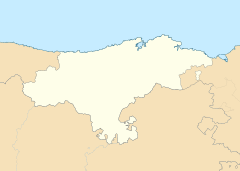Cave del Valle (Cantabria)
Cueva del Valle | |
 cave entrance | |
| Alternative name | La Viejarrona |
|---|---|
| Location | near El Cerro Village |
| Region | municipality of Rasines, Cantabria, Spain |
| Coordinates | 43°17′55″N 3°25′10″W / 43.29861°N 3.41944°W / 43.29861; -3.41944 |
| Length | 60 km (37.28 mi) |
| History | |
| Periods | Upper Magdalenian |
| Associated with | Paleo-humans |
| Site notes | |
| Excavation dates | 1905, 1996 to 1998 |
Cave del Valle (Spanish: Cueva del Valle, The Valley's Cave), locally also known as La Viejarrona (Old Girl), is located near El Cerro Village in the municipality of Rasines in Cantabria, northern Spain.[1] The cave is the source of the Silencio River, a tributary of the Rio Ruahermosa, which in turn is a tributary of the Asón River. Notable for its prehistoric, but particularly for its speleologic significance as it is recognized as one of the longest cavities in the world. The site is very popular among cavers, who have explored a total of over 60 km (37.28 mi) so far.[2]
Prehistoric occupation

Although situated in the renown Franco-Cantabrian region, the discovery of prehistoric rock paintings has never been reported. In 1905 a priest named Lorenzo Sierra discovered the first objects, tools and artifacts that account for human occupation as early as 9,000 years ago. Documented are Azilian harpoons and scrapers, Upper Magdalenian spear points and other bone tools. Stone tools include chisels and various types of scrapers.[3] Latest excavations were made from 1996 to 1998. A perforated and decorated stick of archaeological interest was found at this site, but is now lost. However, the National Archaeological Museum retains a copy and there exists another pierced pole, preserved in the Regional Museum of Prehistory and Archaeology of Cantabria, although of less importance than the lost specimen as it is not decorated.[4]
Caving site
The cave of the valley is recognized as one of the longest explored caves in the world with more than 40 mi (64.37 km) yet explored. The site is, apart from professional speleologists, also well known among sport - and hobby practitioners of caving.[5][6][7]
See also
References
- ^ "El Cerro - Google Maps". Google Maps. Retrieved January 8, 2017.
- ^ "RRCPC Newsletter Vol.41 No.1 Article 1 Red del Silencio is the second longest cave system in Spain (c. 60km long)". Rrcpc org. Retrieved January 8, 2017.
- ^ Díaz-Andreu, Margarita (13 November 2012). Archaeological Encounters: Building Networks of Spanish and British ... - Margarita Díaz-Andreu -. ISBN 9781443842761. Retrieved January 8, 2017.
- ^ Pérez, María Paz García-Gelabert; Costa, Julián Talavera (2004). La cueva del Valle, Rasines, Cantabria, España (in Spanish). J. and E. Hedges. ISBN 978-1-84171-365-6.
- ^ "WORLDS LONGEST CAVES". Caverbob com. Retrieved January 8, 2017.
- ^ "PICTURE COVERS – REAL CAVES" (PDF). Caveinspiredmusic com. Archived from the original (PDF) on January 8, 2017. Retrieved January 8, 2017.
- ^ "The South Wales Caving Club 2013 Cantabria Expedition" (PDF). Swcc org. Retrieved January 8, 2017.
External links
- Margarita Díaz-Andreu (13 November 2012). Archaeological Encounters: Building Networks of Spanish and British Archaeologists in the 20th Century. Cambridge Scholars Publishing. pp. 206–. ISBN 978-1-4438-4276-1.

